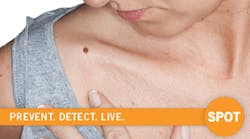Skin cancer is the most common cancer in the United States and finding spots that could be cancerous is as simple as looking at your skin. Now, a new video, “Skin Self-Exam: How To Do,” from the American Academy of Dermatology demonstrates how to check your skin and what to look for.
“Checking your skin for skin cancer only requires your eyes and a mirror. Involving a partner adds another set of eyes, which is especially helpful when checking the back and other hard-to-see areas,” said Thomas E. Rohrer, MD, FAAD, a board-certified dermatologist in private practice in Chestnut Hill, Mass. “Examining your skin only takes a few minutes, but it could save your life.”
When examining the skin, look for the ABCDEs of melanoma and see a doctor if any moles exhibit these signs:
A – Asymmetry: One half of the spot is unlike the other half.
B – Border: The spot has an irregular, scalloped or poorly defined border.
C – Color: The spot has varying colors from one area to the next, such as shades of tan, brown or black, or with areas of white, red or blue.
D – Diameter: Melanomas usually are greater than 6mm, or about the size of a pencil eraser when they are diagnosed, but they can be smaller.
E – Evolving: A mole or spot on your skin that looks different from the rest or is changing in size, shape or color.
To check your skin, looking at the front and back of your body. When examining your own skin, stand in front of a mirror. Examine your skin by following these steps:
- Raise your arms and examine the right and left sides of your body.
- Then bend your elbows and look carefully at your forearms and upper underarms.
- Examine the back of your legs, the spaces between your toes and the soles of your feet.
- Examine those hard‐to see areas like your back, buttocks and the top of your head. Use a mirror to inspect the back of your neck and scalp, parting your hair for a better view.
“Current estimates show one in five Americans will be diagnosed with skin cancer in their lifetime, so it’s important to be familiar with your skin, especially your moles,” said Rohrer. “Catching skin cancer early is key for successful treatment, so check your skin regularly and see a board-certified dermatologist if you spot anything suspicious.”
The American Academy of Dermatology has a SPOT Skin Cancer public awareness initiative. Visitors to the program’s Web site can find stories of those affected by skin cancer and free downloadable materials to educate others in their community.
